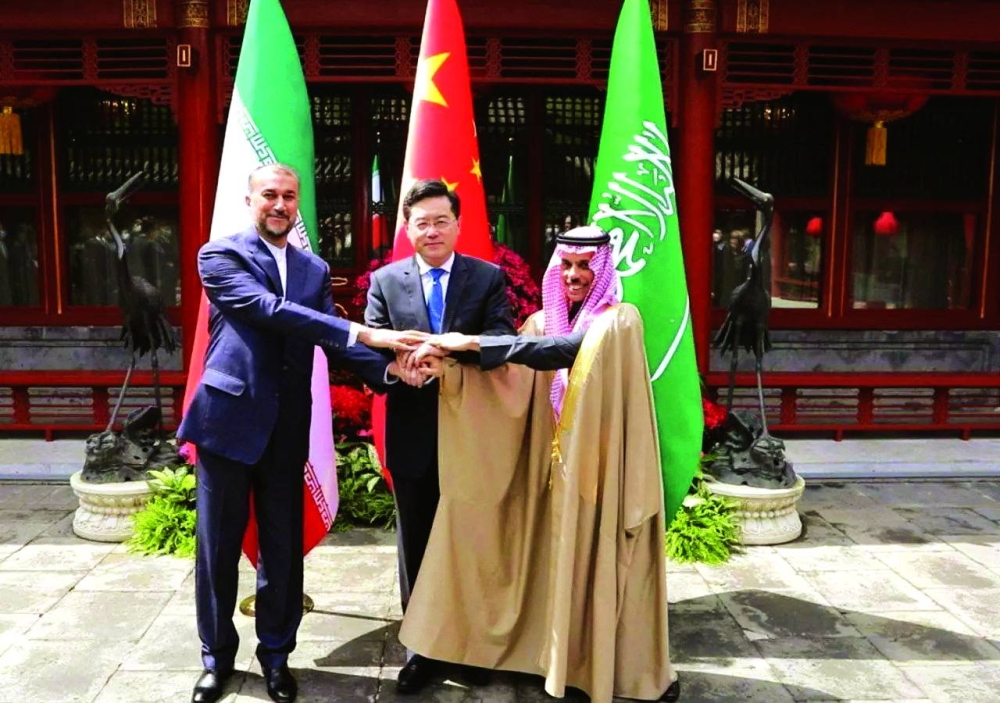Top diplomats from Iran and Saudi Arabia met in Beijing yesterday, resuming diplomatic relations and pledging to work together to bring “security and stability” to their turbulent region.
In a joint statement released after talks between Iranian Foreign Minister Hossein Amir-Abdollahian and Saudi counterpart Prince Faisal bin Farhan, the two sides vowed to continue to work together to improve ties.
In a tweet, Amir-Abdollahian said that the meeting with his Saudi counterpart was “positive”, adding that “the emphasis on stability and sustainable security” were among the issues agreed upon and “on the common agenda”.
The meeting came after a surprise Chinese-brokered deal in March put Tehran and Riyadh on a path to restore relations that had been severed seven years ago when protesters in Iran attacked Saudi diplomatic missions.
“The two sides emphasised the importance of following up on the implementation of the Beijing Agreement and its activation in a way that expands mutual trust and the fields of co-operation and helps create security, stability and prosperity in the region,” a joint statement released yesterday said.
Chinese Foreign Minister Qin Gang “witnessed the signing of a joint statement between Saudi Arabia and Iran, and the two countries announced the resumption of diplomatic relations with immediate effect”, the ministry said.
French President Emmanuel Macron and EU chief Ursula von der Leyen were also in the Chinese capital yesterday, seeking to make Europe’s case in a meeting with Xi Jinping for bringing an end to the conflict in Ukraine.
Macron, in joint remarks to the media alongside Xi, welcomed the Iran-Saudi thaw as he congratulated his Chinese counterpart for securing “this important step forward”.
The shock rapprochement between mainly Sunni Muslim Saudi Arabia, the world’s biggest oil exporter, and Shia-majority Iran, strongly at odds with Western governments over its nuclear activities, has the potential to reshape relations across a region characterised by turbulence for decades.
Saudi state TV channel Al Ekhbariya aired footage of the pair of diplomats shaking hands in front of Saudi and Iranian flags and then talking and smiling.
Under last month’s agreement, the two countries are to reopen their embassies and missions within two months and implement security and economic co-operation deals signed more than 20 years ago.
“The technical teams will continue co-ordination to examine ways of expanding co-operation, including the resumption of flights and bilateral visits of official and private sector delegations and facilitating the granting of visas for the citizens of the two countries,” yesterday’s joint statement said.
Saudi Arabia severed relations with Iran in January 2016, after protesters attacked its embassy in Tehran and consulate in the Iranian city of Mashhad over Riyadh’s execution of the Saudi opposition Shia cleric Nimr al-Nimr.
Talks between the foreign ministers are expected to be followed by Iranian President Ebrahim Raisi’s visit to Riyadh.
Raisi accepted an invitation from Saudi Arabia’s King Salman, Iran’s First Vice-President Mohamed Mokhber said on Monday.
The United States has for decades been the key diplomatic power in the Middle East and has an alliance, albeit a frequently strained one, with Saudi Arabia.
Washington has cautiously welcomed the rapprochement between the Saudis and US adversary Iran despite the role of China, which it sees as its biggest global challenger.
“If this dialogue leads to concrete actions by Iran to curb its destabilising activities in the region, including the proliferation of dangerous weapons, then of course we would welcome that,” US State Department spokesman Vedant Patel told reporters in Washington.
US Central Intelligence Agency (CIA) Director Bill Burns has meanwhile travelled to the kingdom to reaffirm in talks with his counterparts and national leaders decades-old intelligence co-operation, including on counterterrorism, a US official revealed yesterday.
The official did not disclose when Burns’ visit took place.
The Washington Post, which first reported it, said it was earlier this week.
Iran and Saudi Arabia support rival sides in several conflict zones across the region, including in Yemen, where Houthi rebels are backed by Tehran and Riyadh leads a military coalition supporting the government.
It is unclear whether the restoration of diplomatic relations could help bolster peacemaking in Yemen, where Saudi Arabia has been in tough talks with the Houthis on a permanent ceasefire.
The two sides also vie for influence in Syria, Lebanon and Iraq.
Experts said that Beijing’s role would likely increase confidence that any deal would stick.
“Because China is a strong backer of Iran, Saudi should have more confidence in Iran’s ability to comply with the agreement, an issue that has always been in doubt,” said Joel Rubin, a former State Department official.
Yesterday’s meeting “suggests that the process hasn’t gone off track since the Beijing announcement last month”, said Ali Vaez, director of the International Crisis Group’s Iran Project. “But it’s still early days to judge whether this is just a tactical detente or a way-station towards strategic rapprochement.”
Officials from Iran and Saudi Arabia held several rounds of dialogue in Baghdad and Oman before they met in Beijing.
In 2016 several Gulf countries followed Riyadh’s action in scaling back ties with Tehran, but they have led the way in restoring diplomatic relations.
Iran welcomed an Emirati ambassador last September, after a six-year absence, and on Wednesday named its own ambassador to the UAE following a nearly eight-year hiatus.
It said last year Kuwait had sent its first ambassador to Tehran since 2016.
Iran has also welcomed a potential rapprochement with Bahrain, a close Saudi ally, which in the past accused Iran of backing a Shia-led uprising in the Sunni-ruled kingdom, an accusation Tehran denies.
Region
Iran, Saudi Arabia vow to bring Mideast ‘security and stability’
Top diplomats from Iran and Saudi Arabia met in Beijing yesterday, resuming diplomatic relations and pledging to work together to bring “security and stability” to their turbulent region.

Iran’s Foreign Minister Hossein Amir-Abdollahian with Saudi Arabia’s Foreign Minister Prince Faisal bin Farhan al-Saud and Chinese Foreign Minister Qin Gang shake hands in Beijing.
